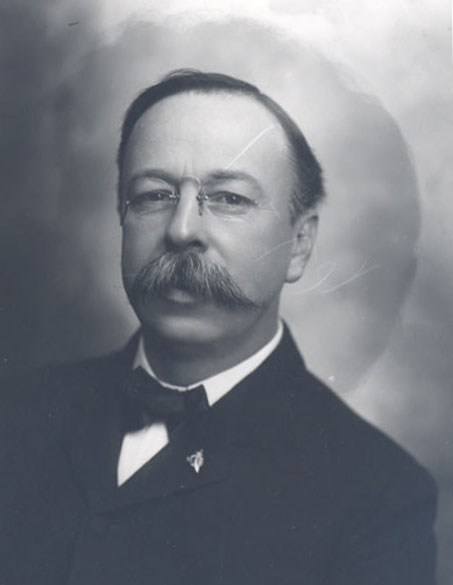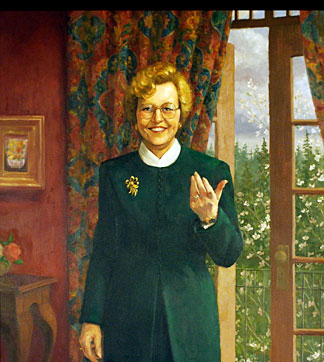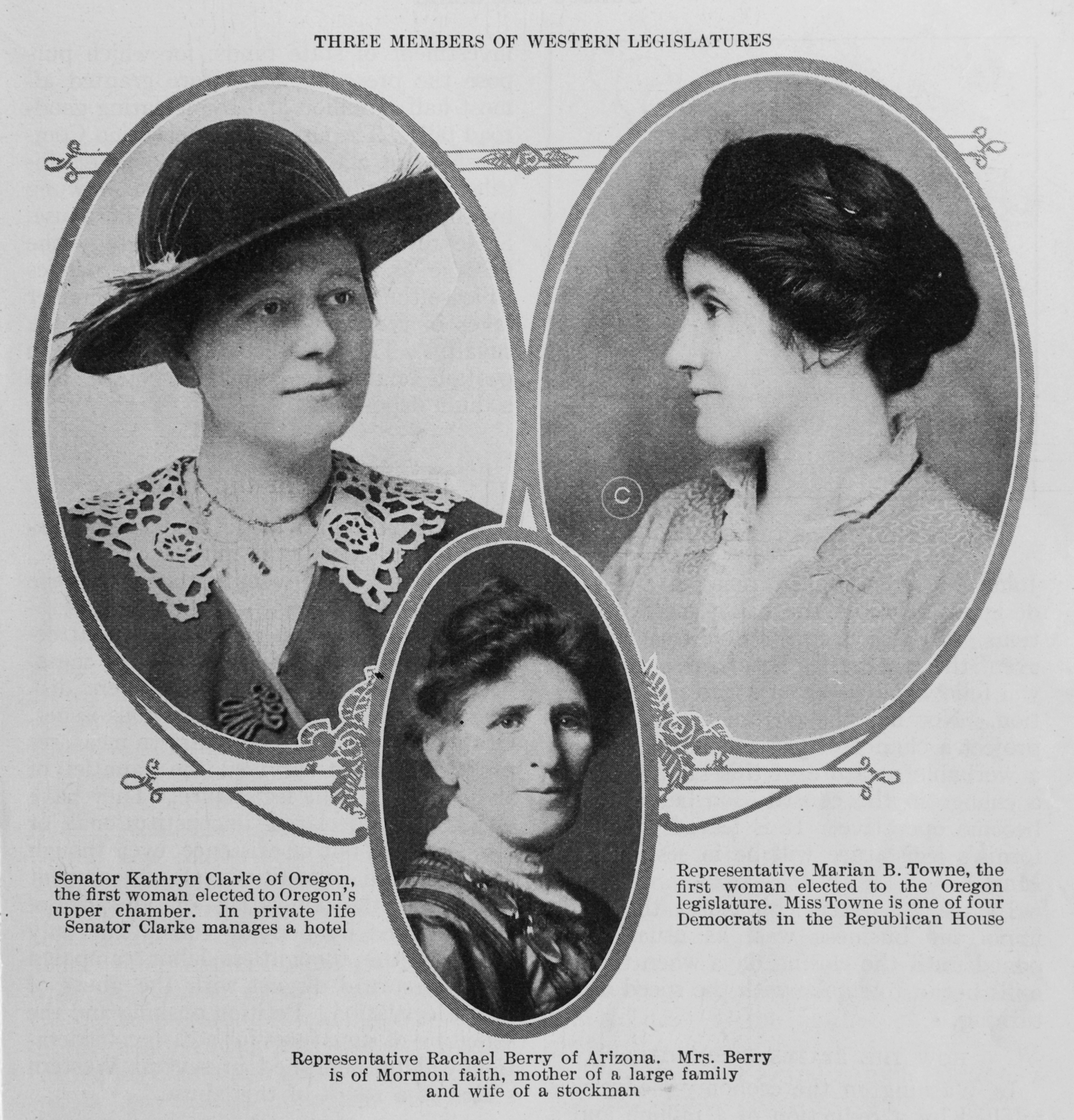Oregon Governor Caralyn B. Shelton is recognized as the first woman acting governor in the United States. She served in that position during the transition between the George E. Chamberlain and Frank E. Benson administrations in 1909, three years before Oregon women were granted full voting rights.
Carrie Bertha Skiff was born in Union on October 3, 1876, the daughter of Willis Skiff and Mary Calista (née Moe) Skiff. She was one of nine siblings in a family that lived comfortably in the small eastern Oregon town; but her father disappeared under mysterious circumstances when she was nine years old, and her mother died when she was eleven. Carrie and two siblings—a brother and sister—lived with their brother Orrin and his wife until 1888, when the court appointed guardianship of the two girls to John W. and Delilah Shelton. John Shelton was a wealthy attorney and businessman in Union and was president of the State Board of Equalization during Governor Sylvester Pennoyer’s administration (1887–1895).
On October 27, 1892, sixteen-year-old Carrie Skiff and her guardian, John Shelton, were married in Weiser, Idaho, and the couple moved to Portland. A month earlier, Shelton had filed for divorce while his wife and Carrie’s sister were on a trip to California. After Shelton died in Portland on September 12, 1894, the divorce was overturned by the courts and his marriage to Carrie Shelton was annulled.
In Portland, Shelton obtained a job as a stenographer with the law firm Starr, Thomas, and Chamberlain. With an aptitude for legal terminology, she drew up deeds, mortgages, and other legal papers, work usually entrusted to a male law clerk. In 1900, when law partner George E. Chamberlain was elected district attorney of Multnomah County, she continued working for him and learned criminal law and how to draw up indictments.
In 1901, at Chamberlain’s suggestion, Shelton changed her name to Caralyn to better fit her position as his private secretary and to reduce confusion with his daughter Carrie. When he was elected governor in 1902, she accompanied him to Salem and took the oath of office, first as his stenographer, then as his private secretary. With no designated governor’s mansion, Chamberlain kept his residence in Portland, and both he and Shelton boarded with the Cooke-Patton family when they were in Salem. Shelton often assisted Chamberlain with state and social affairs in the capital city, including during the 1903 visit of President Theodore Roosevelt.
On August 6, 1904, the Oregon Statesman reported that Shelton had been left in charge of the Executive Office while Chamberlain was in Portland visiting family. With no lieutenant governor position in Oregon, it was common for the governor’s private secretary, who was generally male, to act as head of state. This practice drew national attention in February 1909 after Chamberlain was elected to the U.S. Senate.
Chamberlain’s election to the Senate had been contentious, the first under the direct primary law whereby voters instructed legislators to ratify the winner of the popular vote, despite party affiliation. Chamberlain, a Democrat, faced a Republican majority legislature, which wrangled for eight months before confirming his election on January 19, 1909. Chamberlain had to be in Washington, D.C., on March 4 to be sworn in as Oregon’s new senator.
State law was clear that the governor’s successor would be Secretary of State Benson, but Benson was undergoing treatment for cancer in another state and could not make it to Salem before Chamberlain had to depart by train. Chamberlain’s male secretary, Robert Caples, was sent ahead to Washington, and Caralyn Shelton was made acting governor to provide stability through the transition. In an interview in the Oregonian on February 13, Chamberlain praised her abilities and the range of her skills. For her part, Shelton told the reporter: “I shall try to show that a woman can conduct the affairs of a Governor’s office as well as a man can.”
“Oregon Has Today a Woman Governor,” the Daily Capital Journal reported. During her tenure as the first woman governor of Oregon, which lasted from February 27 until March 1, Shelton focused on routine duties such as requisitions and extradition matters. On Benson’s arrival in Salem, she presented him with the governor’s resignation as well as her own and then traveled to Washington, D.C., to continue her work for Senator Chamberlain.
In Washington, Shelton found that she had become a celebrity among women and was sought after by the press, government officials, and women’s organizations, particularly those promoting woman suffrage. The Washington, D.C., Evening Star, described her as “a woman with a charming manner, and behind it all a subtle personality. Mrs. Shelton is capable and a born executive. This is the woman to whom one could not easily lie or ask to enter a crooked deal. This is the woman who has proven her ability.”
In addition to her secretarial duties, Shelton was appointed senate clerk to the Committee on Public Lands and the Committee on Military Affairs, which Chamberlain served on. She worked for Military Affairs during the lead-up to World War I, when the committee considered legislation on the draft, food control, and financing. Chamberlain was critical of the government’s inefficiency and military readiness, and his opposition to President Woodrow Wilson contributed to his defeat in November 1920.
When Chamberlain left office, Shelton continued working as his private secretary in Washington, D.C., where he practiced law and served on the U.S. Shipping Board. In February 1926, nine months after his wife died, Chamberlain suffered a paralytic stroke. Shelton and two of his children reached an agreement that she and Chamberlain would join in a marriage of convenience. She would continue as his private secretary with the added duties of wife and caretaker. In exchange, she would receive financial support until his death and would be buried at his side in Arlington National Cemetery. The couple was married in Norfolk, Virginia, on July 12, 1926. Chamberlain died two years later, on July 9, 1928. Shelton returned to Oregon in 1933.
Caralyn B. Shelton died in Salem on February 3, 1936, and was buried in Arlington National Cemetery.
-
![]()
Caralyn B. Shelton.
Courtesy Willamette Heritage Center, Caralyn B. Shelton Collection -
![]()
"Oregon has woman governor pro tem," Boston Globe, March 1, 1909.
Boston Globe
-
![]()
Caralyn B. Sheldon, 1914.
Courtesy Library of Congress, LC-DIG-hec-03926 -
![]()
"Governor Chamberlain goes to Washington on February," Statesman Journal, February 14, 1909.
Salem Statesman Journal
-
![George Chamberlain]()
George Chamberlain.
George Chamberlain Courtesy Oreg. Hist. Soc. Research Lib., neg. no.023377
Related Entries
-
![Barbara Kay Roberts (1936–)]()
Barbara Kay Roberts (1936–)
In November 1990, Barbara Roberts became the thirty-fourth governor of …
-
![George Chamberlain (1854-1928)]()
George Chamberlain (1854-1928)
Largely because of his reputation as a scrupulously honest attorney gen…
-
![Kathryn Clarke (1873-1940)]()
Kathryn Clarke (1873-1940)
Kathryn Clarke, the first woman to serve in the Oregon Senate, made wor…
-
![Marian B. Towne (1880 - 1966)]()
Marian B. Towne (1880 - 1966)
As the first woman elected to the Oregon House of Representatives (1914…
Related Historical Records
Map This on the Oregon History WayFinder
The Oregon History Wayfinder is an interactive map that identifies significant places, people, and events in Oregon history.
Further Reading
Caralyn B. Shelton collection, 2019.013. Willamette Heritage Center, Salem, Oregon.
George Earle Chamberlain papers, Mss 1025. Oregon Historical Society Research Library, Portland.
Hendricks. Russell G. “Election of Senator Chamberlain, the People’s Choice." Oregon Historical Quarterly 53 (June 1952): 63–88.








